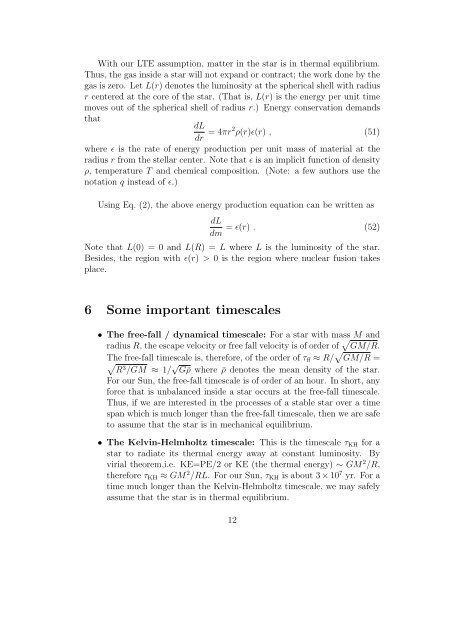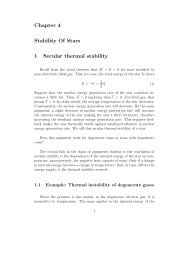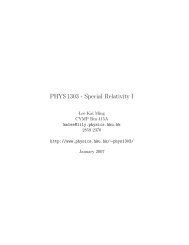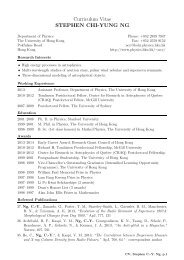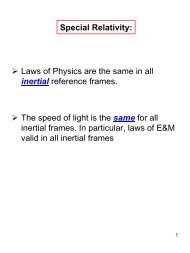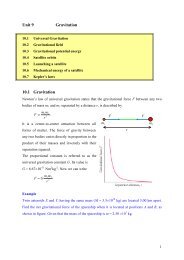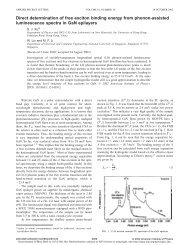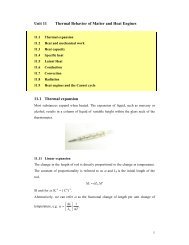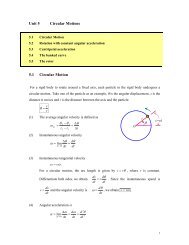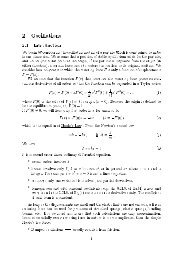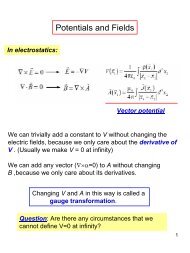Chapter 2 Stellar Structure Equations 1 Mass conservation equation
Chapter 2 Stellar Structure Equations 1 Mass conservation equation
Chapter 2 Stellar Structure Equations 1 Mass conservation equation
You also want an ePaper? Increase the reach of your titles
YUMPU automatically turns print PDFs into web optimized ePapers that Google loves.
With our LTE assumption, matter in the star is in thermal equilibrium.<br />
Thus, the gas inside a star will not expand or contract; the work done by the<br />
gas is zero. Let L(r) denotes the luminosity at the spherical shell with radius<br />
r centered at the core of the star. (That is, L(r) is the energy per unit time<br />
moves out of the spherical shell of radius r.) Energy <strong>conservation</strong> demands<br />
that<br />
dL<br />
dr = 4πr2 ρ(r)ϵ(r) , (51)<br />
where ϵ is the rate of energy production per unit mass of material at the<br />
radius r from the stellar center. Note that ϵ is an implicit function of density<br />
ρ, temperature T and chemical composition. (Note: a few authors use the<br />
notation q instead of ϵ.)<br />
Using Eq. (2), the above energy production <strong>equation</strong> can be written as<br />
dL<br />
dm<br />
= ϵ(r) . (52)<br />
Note that L(0) = 0 and L(R) = L where L is the luminosity of the star.<br />
Besides, the region with ϵ(r) > 0 is the region where nuclear fusion takes<br />
place.<br />
6 Some important timescales<br />
• The free-fall / dynamical timescale: For a star with mass M and<br />
radius R, the escape velocity or free fall velocity is of order of √ GM/R.<br />
The free-fall timescale is, therefore, of the order of τ ff ≈ R/ √ GM/R =<br />
√<br />
R3 /GM ≈ 1/ √ G¯ρ where ¯ρ denotes the mean density of the star.<br />
For our Sun, the free-fall timescale is of order of an hour. In short, any<br />
force that is unbalanced inside a star occurs at the free-fall timescale.<br />
Thus, if we are interested in the processes of a stable star over a time<br />
span which is much longer than the free-fall timescale, then we are safe<br />
to assume that the star is in mechanical equilibrium.<br />
• The Kelvin-Helmholtz timescale: This is the timescale τ KH for a<br />
star to radiate its thermal energy away at constant luminosity. By<br />
virial theorem,i.e. KE=PE/2 or KE (the thermal energy) ∼ GM 2 /R,<br />
therefore τ KH ≈ GM 2 /RL. For our Sun, τ KH is about 3 × 10 7 yr. For a<br />
time much longer than the Kelvin-Helmholtz timescale, we may safely<br />
assume that the star is in thermal equilibrium.<br />
12


